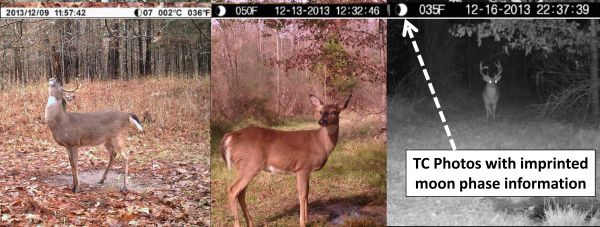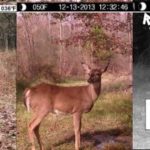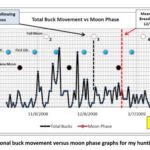
Latest science says, ‘No.’
As regular readers of “Happy Trails” have come to know, I am a trail/scouting camera fanatic, and use the data I derive each season from my web of cameras to tell me when and where deer, and bucks in particular, move on my personal hunting property.
I ascribe to the premise that less is not more when it comes to wringing all you can from a set of trail camera photos. I hunt and manage a several-hundred- acre tract of hunting land. There is an approximately 200-acre core area in the center of my overall property, which is accessed at some point by virtually all of the deer that use my property.
Once the prerut is going full blast, my web of active trail cameras that are placed in this core area usually swells to a total of around 15, which is a practical cutoff for me due to the overall time and effort involved in servicing that many camera sites.
And, yes, I do realize that that number of cameras in the core area translates to an average of roughly one camera per 15 acres, but my goal is to see and monitor as many bucks as possible that use or visit my property, so that is the price that I pay for the additional buck information.
And again, yes, I fully realize and accept that that many camera sites can generate anywhere from several hundred to several thousand photos every week or less — depending on how I set up the individual camera parameters, such as photo burst and re-arm delay.
In select spots, I use a burst of up to three photos per each triggering event, and a re-arm delay as short as every five to 10 seconds. That does generate a lot of photos, but the reward can be well worth it.
As I have stated in “Happy Trails” before, I am all into the “eye candy” aspect of trail camera photos, but for a moderate additional expenditure of time and resources, the potential results for you and your family and friends can be exponentially increased.
What I do with my newly obtained camera data each deer season varies from one year to the next, according to just what I am trying to learn about the ever-evolving movement patterns and tendencies of my local deer herd.
Over time, using my constantly growing trail camera photo database, I have generated a variety of graphs and have drawn numerous conclusions regarding observed buck movement suppressors and enhancers.
My observed buck movement correlations and patterns for my property includes such things as movement versus morning low temperature and daily high temperature, percent cloud cover during daylight hours, average daily wind speed, and weather events and precipitation. Also, buck movement by time of day is easily obtained, including hourly movement, daytime versus nighttime movement, and timing of scrape-line buck visits.
And let’s not forget what can be a “big elephant in the room” topic, according to who you talk to: buck movement in relation to moon phase.
Having been a proponent and user for many years of soluner tables and other moon-related deer movement prediction data, I set out several years ago, using my extensive personal collection of trail camera data, to see just how the moon might or might not be affecting deer movement on my personal hunting property.
My trail camera studies showed no discernable tie between moon phase and deer movement. I know that some people will disagree with this observation, and the moon might have some influence on deer movement in other locals or regions of the country. But my data did not show any clear correlation.
If indeed, the moon was having a minor affect, my personal observations showed that this influence was neutralized or masked by other more-prevalent factors, such as the prevailing weather conditions on any given day.
There has been much written over the years about the moon phase versus game movement phenomenon, and a multi-million-dollar cottage industry has grown out of it, generating books and moon-phase tables and calendars, and such.
In the earlier portion of my more than 40 years of whitetail hunting experience, I was a staunch believer in the moon’s supposed influence over whitetail deer activity, and I would pore over tables of lunar maximums and minimums as I made my hunting plans.
However, slowly over the years I began to realize that my field observations of deer movement did not jibe with the published solunar predictions, and I began to seriously doubt the reliability of the moon theory.
Now, don’t get me wrong: The moon’s gravitational pull does definitely control global tidal flow, and as a result must certainly influence and affect fish and aquatic life, but what about land-dwelling species, such as whitetail deer?
Yesterday I pulled the latest issue of a very popular national deer hunting magazine out of my mailbox, and what to my wondering eyes should appear but an article titled “Moon Theories Tested by Top Deer Scientists.”
Wow, I couldn’t wait to get back inside and sit down to see just what the results were.
As it turns out, according to the findings of three well-known and highly respected deer scientists here in the Southeast, there have been no scientific studies to date that demonstrate any correlation between moon phase and deer activity or movement.
Their conclusions basically mirrored my own non-scientific studies using trail camera data, and clearly showed that the main driving forces for deer movement revolve around weather, time of year and hunting pressure. Their conclusion laid out two definite facts that we can reliably hang our collective hats on, irrespective of what one may choose to believe or not believe regarding the topic of moon phase.
No. 1 — Whitetail deer are crepuscular, which means they tend to always be more active at dawn and at dusk.
No. 2 — There is a roughly three-week period during the deer season, irrespective of your location, when we all need to be in the woods.
These two factors are repeatable and consistent from year to year, regardless of what the moon is doing.
One of the most-powerful things I derive from this latest scientific revelation regarding the moon theory is that, by using my personal trail camera data, I came to the exact same conclusion several years ago — and stopped wasting my time with solunar tables.
Now if that doesn’t illustrate just how powerful and useful our individual collections of trail camera data can be to each of us, I don’t know what will.
I urge all trail camera users to step outside your usual comfort zone and try new methods, and think about new and different ways to get even more out of your camera data. The result can not only be more enjoyable, but it can also have a positive effect on the wall of your den or hunting lodge.




